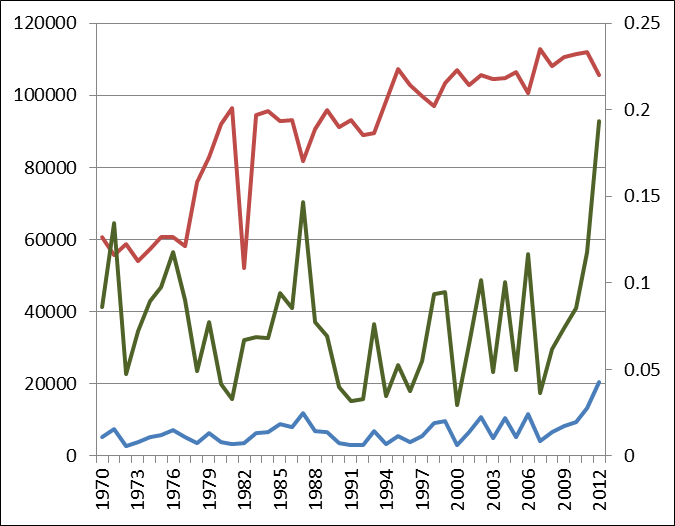In the graph below, the blue line shows the number of passing yards by rookies in each year since 1970, while the red line shows the number of passing yards by non-rookies in the same season. Both are measured against the left Y-Axis; the green line shows the percentage of rookie passing yards to veteran passing yards. As you can see, Andrew Luck, Robert Griffin III, Russell Wilson, Ryan Tannehill, and Brandon Weeden were part of an extremely productive rookie class:

(You can ignore the peak in 1987 — that’s due to the use of replacement players during the NFL strike.)
Historically, of course, running back was the offensive skill position where rookies were most likely to make an impact. This next graph shows the same information but using rushing yards. The blue line shows the number of rushing yards by rookies in each year and the red line shows the number of rushing yards by non-rookies. Both are measured against the left Y-Axis; the green line shows the percentage of rookie rushing yards to veteran rushing yards for each season since 1970. When it comes to passing yards, rookies have historically produced about 10% as many yards as veterans; for rushing yards, rookies are nearly twice as productive. And just like at quarterback, rookie running backs fared pretty well last year, including Alfred Morris, Doug Martin, and Trent Richardson (you can see read some thoughts I had on those three earlier this off-season here).

But when we look at receiving yards, we see a different story. If anything, rookie receivers were more effective in the early ’70s than they are today. When Russell Wilson became the fifth rookie to be announced as his team’s starting quarterback, I discussed the NFL’s youth movement at the position. There, I mentioned Chris Brown’s article on how the younger levels of football have become significantly better at developing quarterbacks and making them ready for the pro game sooner than ever. But you would think an emphasis on the passing game at younger levels would benefit receivers, too. That doesn’t appear to be the case. This next graph shows the same information as the first two graphs, but using receiving yards:

So, I open this question up to the crowd: as more and more college teams do a better job of preparing receivers for the NFL, and more NFL teams are placing more receivers on the field (which I would think would help out rookies generally), why aren’t rookies seeing an increase in the total pie? The graphs above don’t break things down by position, but it’s not like rookie wide receivers can blame the running backs and tight ends for these results. Of the twenty-five wide receivers with the most receiving yards in 2012, none of them were rookies. To be fair, Justin Blackmon and T.Y. Hilton finished 26th and 27th, but the lack of high-end success is a bit surprising. I’ll close with a table showing the top rookie receiver in each season since the merger, as measured by receiving yards, and his rank in that statistic among wide receivers.
And, of course, the ability of the top rookie wide receiver to hold his value is another issue entirely.
